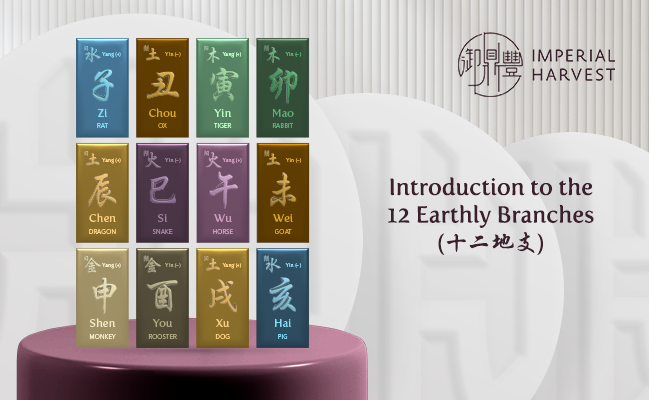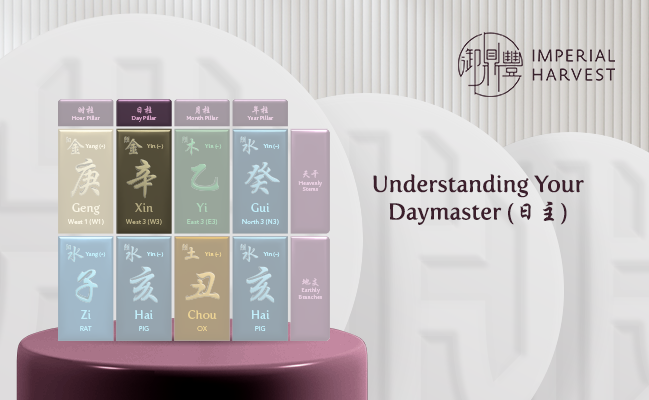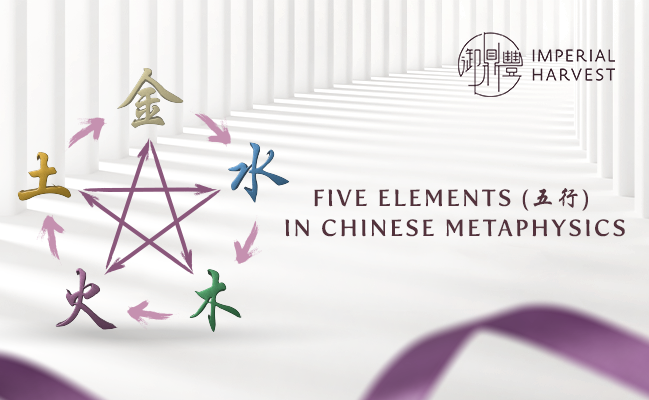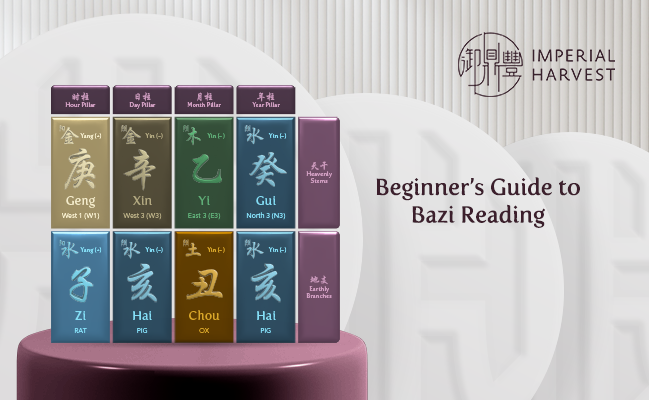

Posted by Imperial Harvest on 20 October 2023
Hidden Heavenly Stems (藏干) in Earthly Branches
Estimated Reading Time: 5 mins
Throughout Chinese history, the 12 Earthly Branches, also known as “地支” (di zhi), have been established as a foundational framework for timekeeping, astrology, divination, and numerous other fields of study.
In this article, we will explore the significance of the 12 Earthly Branches, as well as their Hidden Heavenly Stems to gain greater insight into their roles concerning human nature and the natural world.
Characteristics of the Earthly Branches
The conceptual origins of the 12 Earthly Branches can be traced back to the Shang dynasty (c. 1600 to 1046 BCE), where its foundational theories were based on observations of the planet Jupiter’s orbit around the sun. The 12 Earthly Branches derived their name from the duration Jupiter takes to orbit the Sun — 12 years.
Over the centuries, this system of measurement evolved and became more complex, intertwining with various aspects of Chinese metaphysics.
Besides representing the 12 months in a calendar year, the 12 Earthly Branches also symbolised 12 double-hour segments called Shi Chen (時辰) — which accumulated to 24 hours. In addition, each Earthly Branch aligns with a particular season and is symbolised by a specific zodiac animal.

Hidden Heavenly Stems
This article delves into the 12 Earthly Branches, delving into the meaning and rationale behind the hidden Heavenly Stems within each.
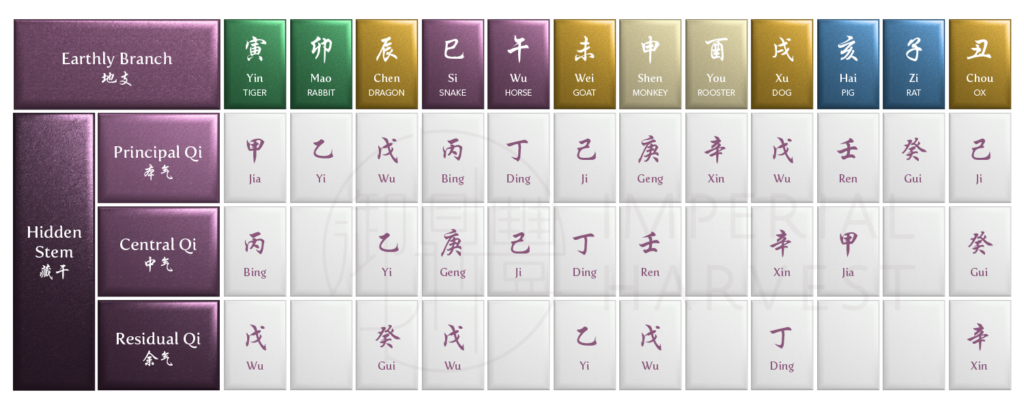
Spring
The three Earthly Branches associated with Spring are Yin (寅), Mao (卯) and Chen (辰), which align with Tiger, Rabbit and Dragon respectively. As Spring represents the Wood element, these three Earthly Branches are referred to as the Three Seasonal Combination (三会) of Wood.
In Bazi, when an individual’s Bazi chart includes the combination of these Earthly Branches, it indicates a strong presence of Wood elemental energy.
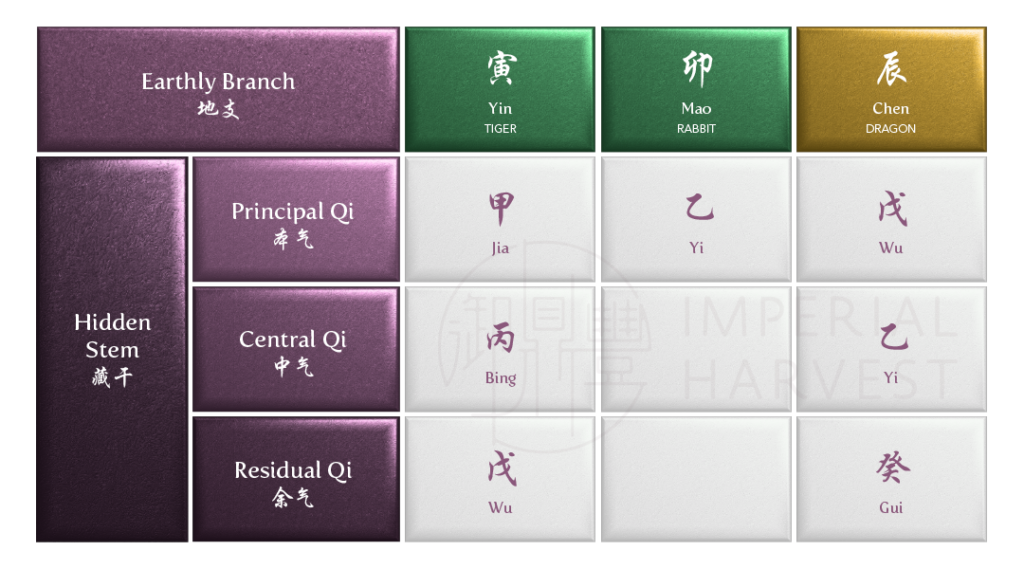
Yin (寅)
Yin represents the Tiger — the first zodiac animal of the Spring season, a Wood elemental season. It aligns with the Yang polarity, represents February in the Gregorian calendar and the time from 3 a.m. to 4.59 a.m.
In the Earthly Branch Yin (寅), three hidden Heavenly Stems contribute varying degrees of energy:
- Jia 甲 (Yang Wood) — Principal Qi (主气): Accounts for 60% of Yin’s energy. Jia Wood emerges as the dominant energy as it represents the start of Spring, aligning with the Wood element.
- Bing 丙 (Yang Fire) — Central Qi (中气): Contributes 30% of Yin’s energy. Although Yin marks the commencement of Spring, it anticipates the coming Summer season. Therefore, Bing Fire is present, representing a transitional energy as Summer approaches.
- Wu 戊 (Yang Earth) — Residual Qi (余气): Made up of the remaining 10% of energy. Earth is the foundational element from which other elements emerge and evolve. Thus, it is fitting that Yin contains Wu Earth, emphasising its importance in signalling the start of a new season.
Mao (卯)
Representing the Rabbit, Mao aligns with the peak of the Spring season. It is of Yin polarity, representing March in the Gregorian calendar and the time from 5 a.m. to 6.59 a.m.
The Earthly Branch Mao (卯) contains a singular Hidden Stem, Yi Wood (乙), to signify its Principal Qi, as the peak of the Spring additionally marks the pinnacle of its elemental energy.
Chen (辰)
Representing the Dragon, the last zodiac animal of the Spring and therefore signifies the end of the season. It is of the Yang polarity, aligning with April in the Gregorian calendar and the time from 7 a.m. to 8.59 a.m.
The three Hidden Heavenly Stems of Chen contribute to varying degrees of energy, and are as follows:
- Wu 戊 (Yang Earth) — Principal Qi: Contributes 60% of Chen’s energy. As Chen marks the end of Spring, Yang Earth emerges as the predominant energy, emphasising the transition to Summer.
- Yi 乙 (Yin Wood) — Central Qi: Yi Wood embodies the essence of Spring as the central Qi. Its Yin quality signifies the concluding phase of Spring, signifying closure and introspection.
- Gui 癸 (Yin Water) — Residual Qi: Accounts for the remaining 10% of energy. Chen ushers in Summer, dominated by the Fire element, overpowering Water. Gui Water in Chen (辰) signifies the last vestiges of water, balancing the transition to scorching Summer. It encapsulates the residual water essence before elemental change.
Summer
Representing the Summer season are the Si (巳), Wu (午) and Wei (未) Earthly Branches, referring to the Snake, Horse and Goat zodiac signs respectively. The Summer season aligns with the Fire element, with the trio of Earthly Branches referred to as the Three Seasonal Combination of Fire.
In Bazi, the presence of this combination of Earthly Branches indicates a strong Fire elemental energy in an individual’s Bazi chart.

Si (巳)
Si represents the Snake, the first zodiac animal of the Summer. Aligning with the Yin polarity, Si also encompasses May in the Gregorian calendar and the time from 9 a.m. to 10.59 a.m.
In the Si Earthly Branch, three hidden Heavenly Stems provide varying degrees of energy, categorised by their significance:
- Bing 丙 (Yang Fire) — Principal Qi: Dominates with 60% of Yin’s energy. As Si represents the commencement of Summer, Bing Fire naturally emerges as the dominant energy, representing the vitality inherent to the season. Despite the Snake’s Yin nature, its role in the initiation of a season — an inherently Yang concept — results in Bing Fire taking precedence as the principal Qi.
- Geng 庚 (Yang Metal) — Central Qi: Contributes 30% of Yin’s energy. Although Si marks Summer’s beginning, it also anticipates the upcoming Autumn season, which aligns with the Metal element. Therefore, Geng Metal is present and hints at the impending Autumn.
- Wu 戊 (Yang Earth) — Residual Qi: Accounts for the remaining 10% of energy. The Earth element is foundational in this seasonal cycle, serving as a foundation for the shift between seasons. Despite the Snake’s Yin nature, Wu (Yang Earth) in Si exemplifies the “Yang within Yin” concept and highlights the intricate interactions within nature, illustrating Si’s cyclical role in the evolution of seasons.
Wu (午)
Wu represents the Horse — the second animal of the Summer season. Encompassing the peak of Summer, Wu is of the Yang polarity, representing the month of June and the period from 11 a.m. to 12.59 p.m.
Within the Wu Earthly Branch, two Hidden heavenly Stems contribute to its energy:
- Ding 丁 (Yin Fire) — Principal Qi: Contributes 70% of Wu’s energy. Representing the peak of the season, Yu carries with it a Yang quality. However, the presence of Ding Fire emphasises the “Yang within Yin” concept, reflecting the transition into the Autumn season.
- Ji 己 (Yin Earth) — Central Qi: Accounts for the remaining 30% of energy. Yin Earth embodies the concept of “Yin within Yang”, ensuring a balance of Yin and Yang, reflecting the essence of transition and equilibrium central to Chinese Metaphysics.
Wei (未)
Wei aligns with the Goat, the last animal of the Summer. Hence, it also signifies the end of the season and aligns with the Yin polarity. It represents the month of July and the time from 1 pm to 2.59 pm.
Within the Wei Earthly Branch, three Hidden Heavenly Stems contribute to its energy, and are listed as follows:
- Ji 己 (Yin Earth) — Principal Qi: Makes up 60% of Wei’s energy. As Wei marks the end of Summer, Yin Earth emerges as the principal Qi, underscoring the transition into Autumn.
- Ding (丁, Yin Fire) — Central Qi: Ding Fire, as the central Qi, embodies the elemental essence of Summer. It mirrors the Yin aspect of the waning season, symbolising a time of closure and introspection.
- Yi 乙 (Yin Wood) — Residual Qi: Yi Wood contributes the remaining 10% of Wei (未)’s energy. Wei (未) marks the transition into Autumn, a season dominated by the Metal element, signifying the decline of the Wood element. The presence of Yi Wood in Wei (未) represents the last remnants of Wood before the onset of Metal-dominated Autumn.
Autumn
Autumn is represented by the Earthly Branches, Shen (申), You (酉) and Xu (戌) — aligning with the Monkey, Rooster and Dog zodiac signs respectively. Autumn is associated with the element of Metal, therefore this combination of Earthly Branches is termed the Three Seasonal Combination of Metal.
A collective presence of this trio of Earthly Branches in an individual’s Bazi chart is indicative of a strong metal elemental energy.

Shen (申)
Shen corresponds to the Monkey, the initial zodiac sign of Autumn, representing the Metal element. With a Yang polarity, Shen aligns with August in the Gregorian calendar and spans from 3 p.m. to 4:59 p.m.
The three Hidden Heavenly Stems within the Shen Earthly Branch are as follows:
- Geng 庚 (Yang Metal) — Principal Qi: Consisting 60% of Shen’s energy, Geng Metal is the dominant force, with Shen ushering in the Autumn season.
- Ren 壬 (Yang Water) — Central Qi: Comprising 30% of Shen’s energy, Ren Water signifies the forthcoming Winter, expressing in a minor capacity in Shen’s Hidden Heavenly Stems.
- Wu 戊 (Yang Earth) — Residual Qi: The remaining 10% of Shen’s energy is represented by Yang Earth. Earth is the foundational element from which other elements grow and sustain themselves. In Shen, the start of the Autumn season, the presence of Earth underscores the essential role the Earth plays in ushering in a new season.
You (酉)
Representing the Rooster, You is the second zodiac animal of the Autumn season, signifying the Autumn’s peak. It aligns with the Yin polarity, marking September in the Gregorian calendar and the time from 5 p.m. to 6.59 p.m.
Within the You Earthly Branch, the singular Hidden Stem is Yin Metal (辛), which signifies its Principal Qi. Signifying the peak of the Autumn season, Yin Metal marks the pinnacle of its elemental energy.
Xu (戌)
Xu represents the Dog — signifying the last zodiac animal of Autumn and the end of the season. Xu is of Yang polarity, representing October in the Gregorian calendar and the time from 7 p.m. to 8.59 p.m.
The three Hidden Heavenly Stems of the Xu Earthly Branch are categorised by their significance as follows:
- Wu 戊 (Yang Earth) — Principal Qi: As the zodiac sign marking the end of the Autumn season, Yang Earth makes up the predominant energy, symbolising the season coming to an end.
- Xin 辛 (Yin Metal) — Central Qi: Metal, as the elemental essence of Autumn, is represented in the Central Qi through Xin Metal. It mirrors the waning of the Autumn season.
- Ding 丁 (Yin Fire) — Residual Qi: Ding Fire makes up the remaining 10% of Xu’s energy. Xu marks the transition into Winter, a season dominated by the Water element, indicating the decline of the Fire element. Ding Fire in Xu represents the final traces of fire before the onset of the cold season, maintaining elemental balance during this transition.
Winter
Winter is characterised by the Earthly Branches, Hai (亥), Zi (子) and Chou (丑) — corresponding respectively with the Pig, Rat and Ox zodiac signs. As Winter aligns with the Water element, the confluence of Hai, Zi and Chou is known as the Three Seasonal Combination of Water.
In Bazi, the presence of these Earthly Branches in an individual’s chart indicates a dominant Water elemental energy.
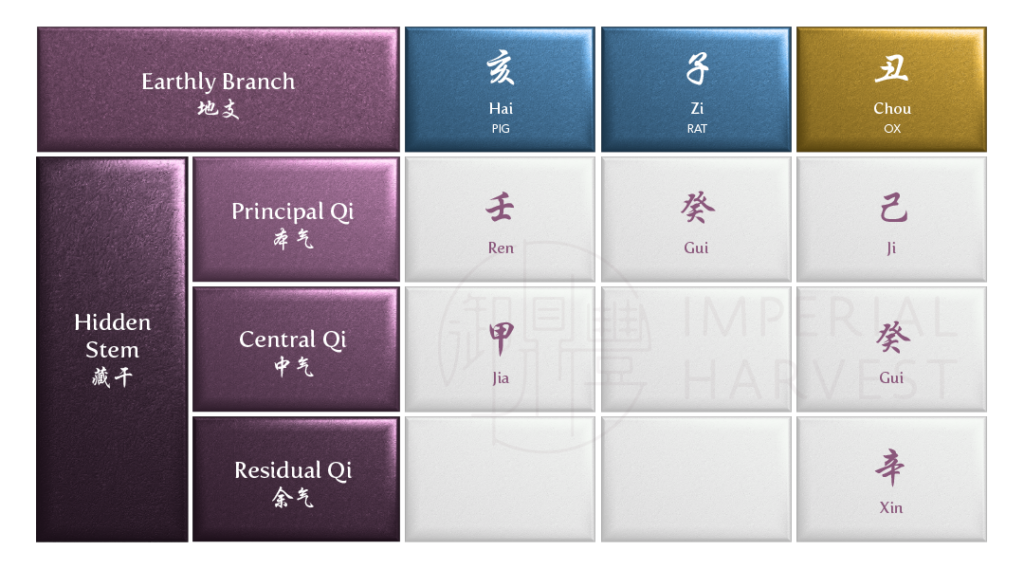
Hai (亥)
The Hai Earthly Branch represents the Pig, the first zodiac animal of the water-dominated Winter season. Aligning with the Yin polarity, Hai represents November and the time from 9 p.m. to 10.59 p.m.
Within the Hai Earthly Branch, two Hidden Heavenly Stems contribute to its energy:
- Ren 壬 (Yang Water) — Principal Qi: Assuming 70% of Hai’s energy, Ren Water naturally emerges as the dominant energy, heralding the vitality inherent to the blossoming Spring season.
- Jia 甲 (Yang Wood) — Central Qi: While Hai marks the commencement of Winter, it also looks towards the coming Spring, a season aligning with the Wood element. Therefore, Wood is present in Hai, foretelling the Wood essence of the coming change in seasons.
Zi (子)
Zi represents the Rat – the second zodiac animal of the Winter season. It signifies the zenith of Winter. It is of Yang polarity. From a time perspective, it represents December in the Gregorian calendar and the time from 11 p.m. to 00.59 a.m.
The Zi Earthly Branch contains one Hidden Heavenly Stem, Gui Water. Its position as the peak of Winter establishes Gui Water as the Principal Qi.
Chou (丑)
Lastly, Chou represents the Ox, the last zodiac animal of the Winter season, signifying the end of the season. It aligns with the Yin polarity, representing the month of January and the time from 1 a.m. to 02.59 a.m.
Within the earthly branch of Chou (丑), three hidden heavenly stems contribute to its energy profile, distinguished by their hierarchical prominence:
- Ji 己 (Yin Earth) — Principal Qi: As the zodiac heralds the end of the Winter season, Ji Earth emerges as a principal energy in Chou, emphasising the close of one season and the transition to the next.
- Gui 癸 (Yin Water) — Central Qi: Accounting for 30% of Chou’s energy, Water is represented as the Central Qi. Its alignment with the Yin polarity mirrors the waning of the Winter season.
- Xin 辛 (Yin Metal) — Residual Qi: Xin Metal constitutes the remaining 10% of Chou (丑)’s energy. Chou (丑) marks the transition into Spring, characterised by the Wood element, indicating the waning of the Metal element. Xin Metal in Chou (丑) represents the final traces of metal before the arrival of the Wood-dominated Spring, maintaining elemental equilibrium during this transition.
Imperial Harvest’s expert consultants are always on hand to guide you on your journey and provide you with insights to help you realise your fullest potential. Book a complimentary consultation today or contact us at +65 92301640.
We are located at
For prospective clients: Imperial Harvest402 Orchard Road
Delfi Orchard #02-07/08
Singapore 238876 For existing clients: Imperial Harvest Prestige
402 Orchard Road
Delfi Orchard #03-24/25
Singapore 238876
Most Read Articles
Get to read our life changing articles and get inspired.
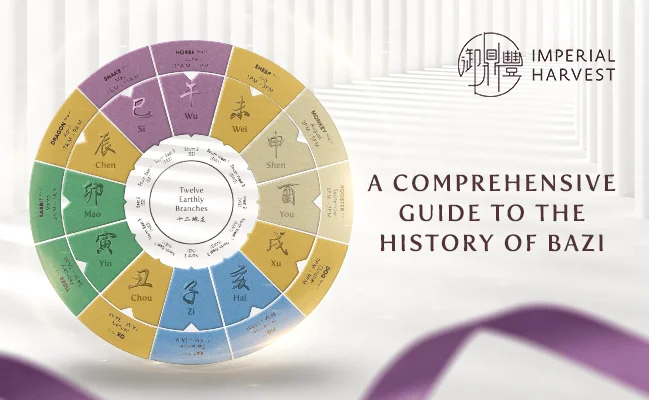
A Comprehensive Guide to the History of Bazi (八字)
Estimated Reading Time: 5 mins Bazi (八字) is often mistakenly assumed as the Chinese counterpart of western Astrology. The similarities between both systems lie in their utilisation of birth dates and time in their calculations, and the ability to be read from a tabulated chart. Where Astrology may take into account the positions of different […]

Imperial Harvest Consecration Ceremony
Estimated Reading Time: 5 mins At Imperial Harvest, each earthly treasure undergoes a series of consecration rites performed by Master David, before it is bestowed upon its blessed owner. Every aspect of these sacred Chinese anointing rituals is carefully examined and accurately represented in Master David’s blessings, reflecting Imperial Harvest’s deep respect for these esteemed […]
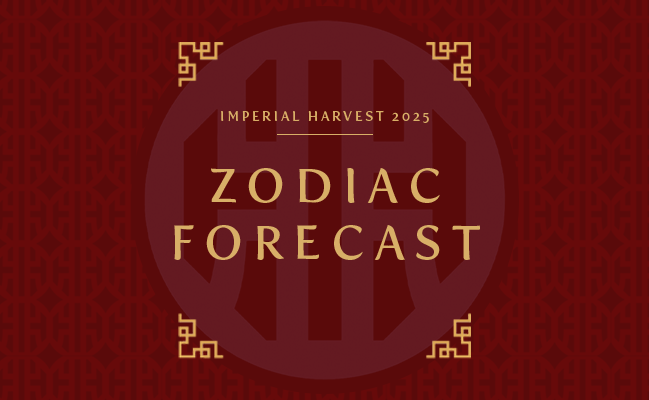
Imperial Harvest 2025 Zodiac Forecast
Estimated Reading Time: 7 mins The Year of the Wood Snake in 2025 brings a dynamic period of growth, transformation, and new beginnings. With its ambitious qualities, the Wood Snake’s influence offers unique opportunities for those who seek progress and renewal. Drawing from the time-honoured principles of Imperial Feng Shui, the Imperial Harvest 2025 Zodiac […]
